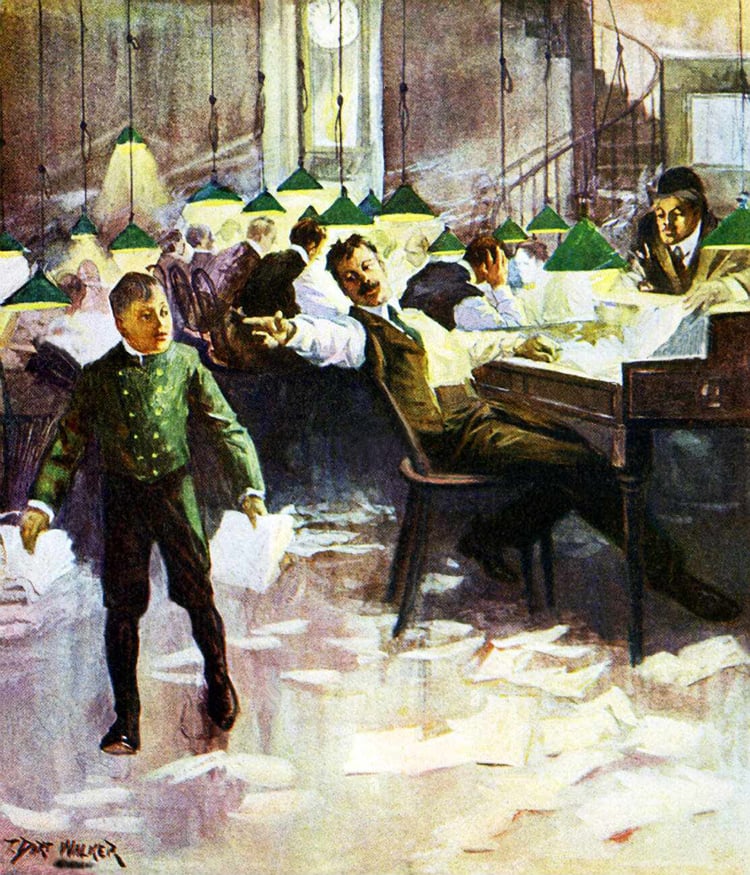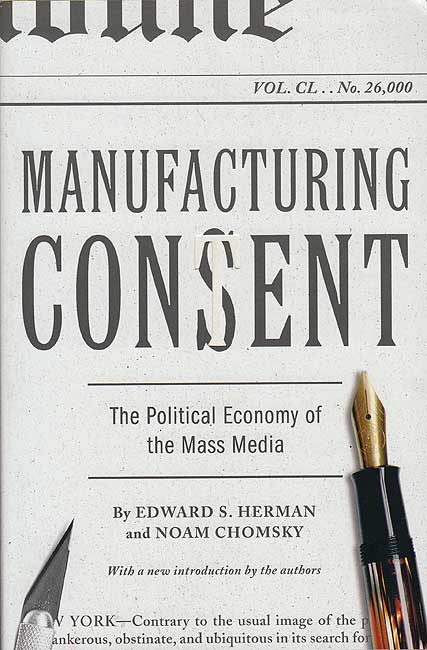by Patrick Keeney (April 2025)

Journalism operates within a simple binary, a distinction G.K. Chesterton captured with his usual wit. The first type consists of straightforward fact-telling— “Journalism largely consists in saying ‘Lord Jones is dead’ to people who never knew that Lord Jones was alive.”
This form of reporting is simple and unembellished. It states what has happened without editorializing, without moral judgment, and without attempting to shape the reader’s reaction. Lord Jones is dead. Make of it what you will.
It is the kind of reporting that once defined serious journalism. It was characterized by a commitment to facts, untainted by the reporter’s personal views or ideological leanings. Readers are treated as adults, capable of drawing their own conclusions. There are no winking hints, loaded adjectives, or breathless insinuations about what one ought to think. Just the facts, as dispassionately and clearly presented as possible.
 The second kind of journalism is more insidious. As Chesterton put it, “The function of the journalist is not to tell what is happening, but to make it happen.” Here, the journalist not only records events but also actively shapes them. It is not enough to say that Lord Jones has died; the public must be instructed on what this means and how we should feel about his death. Was he a saint or a scoundrel? Should his life be regarded as a tragedy or a triumph? Should his legacy be celebrated or memory-holed?
The second kind of journalism is more insidious. As Chesterton put it, “The function of the journalist is not to tell what is happening, but to make it happen.” Here, the journalist not only records events but also actively shapes them. It is not enough to say that Lord Jones has died; the public must be instructed on what this means and how we should feel about his death. Was he a saint or a scoundrel? Should his life be regarded as a tragedy or a triumph? Should his legacy be celebrated or memory-holed?
Long before the term existed, Chesterton was describing what we now call narrative management. This is journalism that not only informs but also persuades and presents facts in a carefully curated reality. It is not concerned with what is true but with what the writer believes ought to be true.
Consider, for instance, the Jussie Smollett farce, where legions of self-proclaimed serious journalists uncritically swallowed the absurd notion that, in the dead of night, in the streets of Chicago, roving MAGA enthusiasts were lurking with bleach and nooses, waiting to pounce on a C-list actor. Or, more egregiously, the Russian collusion hoax, where the media spent years breathlessly insisting that Donald Trump was little more than Putin’s obedient marionette—only for the entire narrative to collapse under the weight of its own fabrication. These weren’t mistakes; they were wilful acts of ideological storytelling, packaged as news.
In a word, this is journalism untethered from objective truth. When this happens, as Chesterton understood, journalism ceases to be a conduit for truth-telling and instead becomes a tool for shaping perception. The reporter is no longer a neutral witness to events but an architect of public opinion, carefully constructing narratives that serve ideological ends rather than factual accuracy.
This is not journalism but propaganda. It does not seek to inform but to persuade. It does not present facts and allow the reader to draw their own conclusions; instead, it selectively arranges facts, omits inconvenient details, and saturates the language with moral judgments to ensure that only one conclusion is possible.
It is in this second category that much of the legacy media now resides. News is no longer delivered as unfiltered fact but as a political act structured to elicit the correct emotional response to direct the public toward approved conclusions. It is not enough to report the plain facts of a protest. The audience must be told whether the protesters are heroic or dangerous. It is not enough to cover a scientific debate. The media must dictate which side of the discussion is the “settled” science and which side is engaging in “denialism.” The goal is not to inform the public but to shape what the public believes.
In Chesterton’s time, this tendency was already evident—a creeping shift in the role of the press from truth-seekers to agenda-setters. What was once a troubling undercurrent has now become a tidal wave. Today, it is the default mode of the legacy media.
But it was not always thus. Journalists in Canada were once guided by a fundamental duty: to seek the truth. Canadians could once boast of a stable of worthy reporters, from Patrick Watson to Pierre Berton, from Barbara Frum to Knowlton Nash, journalists who believed their job was to investigate, question, and report—not to preach, scold, or indoctrinate. These were professionals who, whatever their personal leanings, understood that their first duty was to tell the truth. They understood that journalism was a public trust, not an ideological cudgel. That mission, however, has been abandoned.
It’s difficult to pinpoint when the transformation occurred, but Canada’s legacy media have become ideological enforcers, ensuring that Canadians receive not just the news but the correct interpretation of events. Where once journalists sought to inform, they now seek to instruct. Where once they questioned authority, they now amplify it.
This shift is no accident. This is the manipulation of perception through controlled narratives. As Noam Chomsky and Edward S. Herman argue in Manufacturing Consent: The Political Economy of the Mass Media, the press does not just report reality; it reshapes it to serve those in power. In Canada, this dynamic has played out with ruthless precision, as seen in the legacy media’s recent track record of narrative enforcement.
Trudeau vs. The Truckers
Few events laid bare this phenomenon more starkly than the 2022 Trucker Convoy—a grassroots, working-class revolt against government overreach that sent Canada’s political class into fits of hysteria. What began as a protest against vaccine mandates and draconian COVID restrictions quickly became something more: a moment of reckoning for a government increasingly intolerant of dissent.
The convoy was a remarkable display of civic engagement—truckers waving Canadian flags, singing the national anthem, and even setting up food stalls to feed the homeless. There were bouncy castles for children, impromptu barbecues, and an unmistakable sense of solidarity. And yet, instead of reporting on this unprecedented democratic expression, Canada’s media establishment opted for something else entirely: a full-scale campaign of vilification, distortion, and outright falsehoods.
In an act of craven, wilful blindness, the media uncritically repeated government talking points about the convoy’s supposed ties to white supremacist organizations while ignoring the diverse backgrounds of the protesters themselves. When the Trudeau government froze the bank accounts of protesters—an extraordinary act of financial repression that should have alarmed any self-respecting journalist—the media applauded, arguing that “emergency measures” were necessary to prevent the spread of dangerous ideas.
This was not simply a misrepresentation; it was deliberate narrative engineering. The Canadian public was not being informed. They were being conditioned.
Chomsky and Herman explained this process: the media does not work by censoring inconvenient truths but by omitting them by emphasizing particular perspectives while rendering others invisible. In the case of the trucker protest, the legacy media’s task was not to report fairly but to ensure that dissent was viewed as illegitimate, irrational, and dangerous.
Prime Minister Trudeau resorted to his well-worn tactic of traducing those who stray from the liberal mainstream. The truckers were not to be seen as frustrated workers or ordinary citizens standing up for their rights but as something far more sinister. In his world, dissent is never legitimate—it is always dangerous and driven by the most sinister impulses.
And so, the protest was not about vaccine mandates or government overreach; it was about the government heroically standing up to fascism. It was about defending against racism and the far-right. It was about Islamophobia and misogyny. It was about every conceivable form of bigotry that could be conjured up to delegitimize the entire movement.
Trudeau’s slanders were not offhand remarks. They were part of a calculated strategy that Trudeau and his media allies have perfected. To them, the goal is never to engage with the substance of an argument but to demonize the opposition into irrelevance.
Had the government acknowledged the truckers for what they truly were—a diverse coalition of working-class Canadians weary of excessive state control—the truckers might have garnered widespread public sympathy, which could not be allowed. By recasting them as racists, extremists, and insurrectionists, the Liberals ensured that their voices could be dismissed without consequence.
Trudeau knew the media would reliably do the rest of the work for him. Within hours of his remarks, the CBC, The Toronto Star, The Globe and Mail, and CTV News ran pieces warning of the “far-right extremism” that had infiltrated the convoy. Anchors and columnists earnestly debated the threat to democracy that these truckers posed, as if a few men honking horns in downtown Ottawa were the modern equivalent of a coup d’état. The fact that there was no evidence to support these claims was irrelevant. In the world of Canada’s legacy media, perception is reality. And the perception had to be that the truckers were dangerous, unhinged, and beyond redemption.
What made this reporting all the more absurd was its sheer intellectual laziness. Anyone with eyes to see could instantly grasp the radical disconnect between what the government was saying, the media repeating, and what was transparently the case.
But the demonization of political opponents was Trudeau’s standard script, used against anyone who deviated from progressive orthodoxy. When, for example, working-class Albertans protested his energy policies, they were framed as “climate deniers” standing in the way of social progress. When critics questioned his handling of China’s interference in Canadian elections, they were dismissed as conspiracy theorists. When parents raised concerns about radical gender ideology in schools, they were branded as bigots. It is a playbook as predictable as it is cynical.
Chomsky and Herman described how political leaders, in collusion with the media, frame dissent to ensure it can never be taken seriously. The trick is to attach a stigma to the dissenting group—one that forecloses discussion before it can even begin. A government does not need to censor its critics if it can render them untouchable. The effectiveness of this strategy lies in its ability to bypass debate entirely. If a movement can be branded as “fascist” or “racist,” of “Nazi”, then there is no longer a need to engage with its demands. No respectable person would dare align themselves with it. The mere accusation is enough.
Trudeau understood this dynamic better than anyone. He knew that the CBC, as Canada’s state-funded broadcaster, would never seriously challenge his narrative. He knew that the vast majority of legacy media outlets were ideologically aligned and that they would echo his framing without hesitation. He knew that the entire infrastructure of mainstream opinion-shaping would fall in line to ensure that the truckers were not seen as citizens exercising their rights but as an insurgent force threatening the very fabric of the country.
This was never about whether Trudeau genuinely believed his rhetoric—I doubt he did. It was never about addressing the truckers’ legitimate grievances or concerns. It was about ensuring that dissent would never be seen as legitimate. The truckers’ cause was not to be debated but discredited. Their movement was not to be understood but condemned, framed from the outset as a threat to democracy rather than an expression of democratic participation.
G.K. Chesterton remarked, “It is terrible to contemplate how few politicians are hanged.” He understood that when the press serves as a shield for politicians rather than their watchdog, those in power rarely pay a price for their actions. The media’s role was to manufacture consent for the government’s crackdown, to transform a peaceful protest into a national emergency through sheer repetition and selective framing.
The trucker’s protest was a textbook example of perception management, a carefully orchestrated effort to dictate what the public sees, how they interpret events, and which opinions are deemed acceptable.
The Mass Graves Hysteria
If the trucker protest revealed how the CBC and its allies coordinate narratives to marginalize political dissent, the residential school scandal demonstrated how the media could fabricate a national moral crisis out of thin air, entirely untethered from empirical fact.
In May 2021, Canadians were told that an atrocity of historic proportions had been uncovered. The Tk’emlúps te Secwépemc First Nation announced that a radar survey had identified 215 unmarked graves at the former site of the Kamloops Indian Residential School in British Columbia. The media ran with this unvetted claim, immediately declaring that these were “mass graves” —a phrase that conjured up images of genocide, of children secretly buried after suffering unspeakable horrors.
The story spread with astonishing speed. Newspapers, television programs, and social media exploded with outrage. Churches were burned. Statues were torn down. Prime Minister Justin Trudeau took a knee while grasping a Teddy bear in a show of solemn remembrance, while his government lowered the national flag for five months. The CBC ran story after story about Canada’s “genocidal” past, its legacy of systemic racism, and the urgent need for a national reckoning.
There was just one problem: as of today, no bodies have ever been discovered. Not one. What was found were soil disturbances, not human remains. There was no forensic analysis, no excavation, no confirmation of mass graves. The assumption that these were graves at all was based entirely on ground-penetrating radar readings. This technology detects anomalies in the soil but cannot distinguish between tree roots, stones, clumps of compacted earth, or human remains.
Despite the absence of forensic evidence, the CBC and its fellow media travellers never hesitated. They did not ask questions. They did not urge caution. They did not investigate. They evinced no scepticism. They simply suspended disbelief and repeated the claim that Canada had committed a “cultural genocide” against Indigenous children. And when sceptical voices pointed out the lack of physical evidence, those voices were dismissed as racist, reactionary, or complicit in Canada’s colonial crimes. This is narrative enforcement in the Canadian style.
Chomsky and Herman lay bare the machinery of media-driven mythmaking, revealing how news institutions craft national narratives to entrench power, impose ideological orthodoxy, and silence dissent. The unverified mass graves story is a case in point—an orchestrated media construct deployed to reshape Canada’s cultural identity and justify sweeping policy overhauls.
This marks a pivotal shift in the media’s function, one that Chesterton might have quipped about with his usual acerbic wit: from informing the public to manufacturing public sentiment. Nowhere is this transformation more stark than in Canada’s national broadcaster, the CBC, a state-sanctioned storytelling apparatus.
The CBC and DEI Ideology
The CBC was once a bastion of fair-minded journalism. Canada’s public broadcaster justifiably prided itself on rigorous reporting and a commitment to truth. It employed journalists who saw their role as investigators and questioners, rather than as preachers of dogma or enforcers of ideological orthodoxy. They understood that journalism was a public trust, not a weapon for social engineering. But that was then.
That tradition has been hollowed out by a pervasive ideological shift. The CBC has not merely adopted the language of Diversity, Equity, and Inclusion (DEI) but has been wholly consumed by it. This is not a benign shift toward a more representative media landscape, as we are supposed to believe. Rather, it is a total ideological conversion that recasts every historical event and contemporary issue through the narrow lens of oppression and victimhood. The network’s reporting is now dictated by a rigid moral orthodoxy that ensures only pre-approved narratives see the light of day.
Under this framework, journalism ceases to pursue truth and becomes a crusade for re-education. The journalist’s role is no longer to inform, but to ensure the public thinks the correct thoughts. This explains why certain narratives—such as systemic racism, colonial guilt, and climate alarmism—are amplified without question, while others—government overreach, dissenting voices, or corruption within progressive circles—are ignored, dismissed, or actively suppressed.
The consequences of this shift are stark. When climate activists blockade railways, they are lionized as heroic defenders of the planet. Yet when truckers protest vaccine mandates, daring to exercise their own form of civil disobedience, they are smeared as dangerous insurrectionists. When Indigenous activists seize public buildings, they are celebrated as justice warriors. Ordinary Canadians are ridiculed as conspiracy theorists when they raise concerns about government excess.
This is not a series of organic and unfortunate editorial missteps but a systemic and deliberate realignment of the CBC’s mission. It no longer functions as a public broadcaster serving the citizenry, but rather as a tool of ideological enforcement—a propaganda arm of the progressive political establishment.
The CBC is a textbook example of what Chomsky and Herman warned about: “The media’s role is to serve the needs of powerful groups in society, ensuring that political discourse remains within narrow, carefully controlled limits.”
The real question isn’t whether the CBC and Canada’s media establishment can be reformed, but whether Canadians are willing to confront the uncomfortable truth: these once-trusted institutions have been in the business of narrative building, not fact reporting. Far from being neutral arbiters of truth, they have deliberately shaped public perception—a reality that can no longer be ignored.
Recognizing this is the first step toward reclaiming a media landscape—CBC included—that prioritizes transparency, integrity, and genuine public service, rather than functioning as a taxpayer-funded megaphone for ideological gatekeepers. Canadians should demand nothing less from those whom we entrust to bring us the news.
Table of Contents
Patrick Keeney is a Canadian academic and associate editor of C2C Journal.
Follow NER on Twitter @NERIconoclast
- Like
- Digg
- Tumblr
- VKontakte
- Buffer
- Love This
- Odnoklassniki
- Meneame
- Blogger
- Amazon
- Yahoo Mail
- Gmail
- AOL
- Newsvine
- HackerNews
- Evernote
- MySpace
- Mail.ru
- Viadeo
- Line
- Comments
- SMS
- Viber
- Telegram
- Subscribe
- Skype
- Facebook Messenger
- Kakao
- LiveJournal
- Yammer
- Edgar
- Fintel
- Mix
- Instapaper
- Copy Link







One Response
I would posit that the missing link between factual journalism and the second is the dramatization of events. This doesn’t start out as propaganda, but rather as audience appreciation. It’s a matter of trying to ‘write better’. Which then easily slides into propaganda and narrative building. Good essay.